Is a bigger, wider broadhead more deadly than a smaller, more streamlined head? Let’s look at the basic facts on broadhead design and what that means for you, the hunter.
I’ve avidly collected broadheads for some time. I find it fascinating, an insight into the virtual history of the sport. A common theme of many early heads was an obvious desire to create larger holes in critters. Easy examples including broadheads like the Goshawk (1952), Ben Pearson Deadhead (1964) or Magnum (1971), all providing 1 ¼-inch-plus cutting diameters. As common were strange, yet eye-catching, designs concocted in the attempt to spill more blood. Of the later, since many of these were dismal failures from a practical standpoint, more pointedly from a commercial respect, they have become highly collectible and prized additions to any collection. The earliest broadheads were universally small and streamlined, but with the widespread acceptance of recurves and the energy advantage offered over classic longbows, broadhead designers begin tinkering with the idea of inflicting larger wound channels, no doubt believing bigger holes lead to faster game recovery.
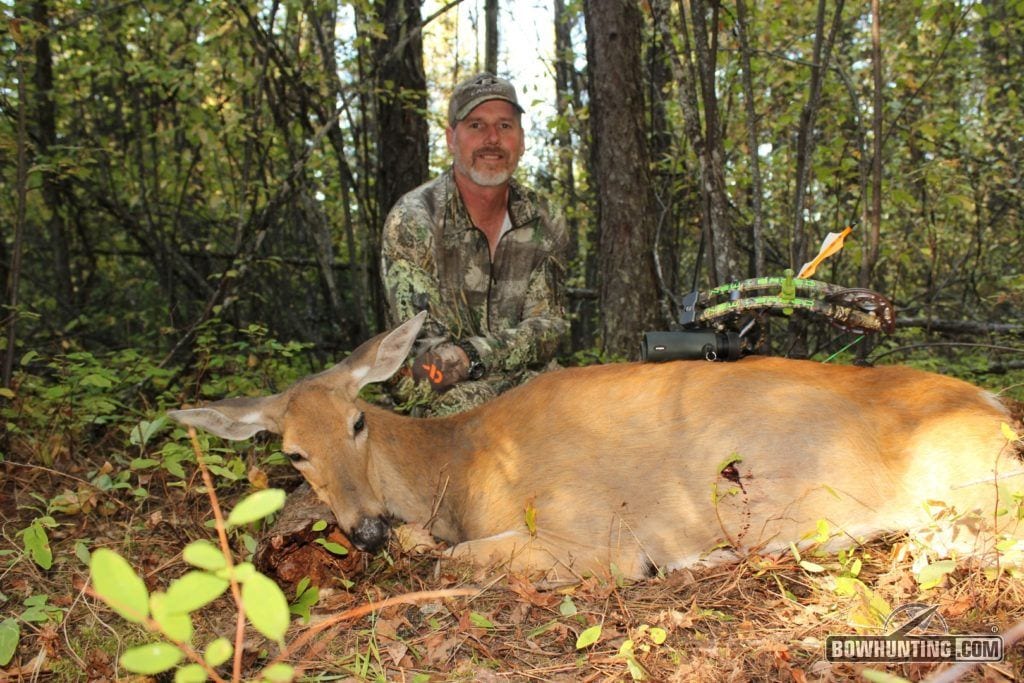
Small fixed blades still work. The author shot this fat doe while still-hunting to fill his extra doe tag. He used a small Muzzy Trocar D6 and hit slightly too far back. Still, the blood trail was good and she didn’t travel far.
Mechanical broadheads appeared in these early experiments. You may believe mechanical broadheads are a relatively new development, but deployable-blade broadheads appeared as early as the 1950s, most failures due to the material limitations of the day, but mostly because developers regularly bit off more than the traditional equipment of the day could chew. Pushing a 2-inch-wide Rage Hypodermic riding a stiff carbon arrow through a deer with a modern, 60-pound compound is one thing, but try to do that with a 2-inch cutting diameter ’57 Mohawk mechanical set on the tip of a Port Orford cedar shaft. I can only imagine what followed, and it wouldn’t be pretty. The 1959 Geronimo (2 ½- to 3 ½-inch swing blades attached to cut-on-contact head) and 1955 Mechanical Killer (resembling a fish point more than a broadhead) suffered similar fates.
Of course modern mechanicals work just fine, with thousands of big game animals falling to them annually.
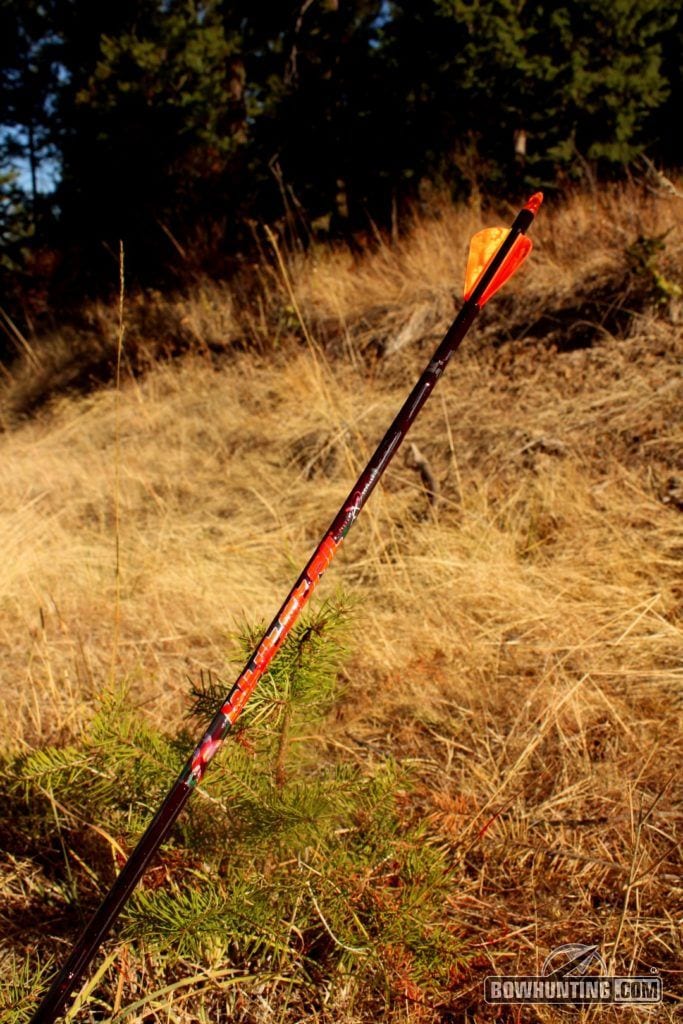
It’s always preferable to achieve pass-through penetration on big game, no matter what kind of broadhead you’re shooting, as two holes spill more blood than one—especially on high hits from elevated positions.
Better engineering and space-age materials make them more efficient and dependable each season. Even those creating the widest cutting diameters, which seems to have settled in the neighborhood of 1 ¾ to 2 inches (though there are the rare mechanicals that are wider). Fine and good, as long as you are shooting enough energy for full penetration. I say this only because bowhunters must always remember (especially those hunting from elevated positions and shooting down on their quarry) that two holes—entrance and exit—are always preferable to just one. You can shove a 2-inch wide mechanical into an animal from above, kill him cleanly and quickly, but without a low exit hole to spill blood, recovery—especially in wet conditions or thick brush—can prove more time consuming. This becomes more pointed with marginal-but-lethal hits where an animal might travel 200 or 300 yards.
Remember, too, physics remain constant: moving parts, wide cutting diameters and blades that chop instead of slice always equal reduced penetration, all other factors remaining equal. If you’re not realizing pass-through penetration on deer-sized game on each and every shot (save those where heavy bone is encountered), it really is time to seek a more efficient broadhead design.
Even if you’re shooting enough energy to achieve pass-through penetration on any game you regularly hunt, the question still bears asking: Do wide-cutting broadheads automatically kill faster than those with less cutting diameter? Or maybe more fairly, since distance traveled after the hit and not time passed is what really counts: Do wider heads always create shorter recovery distances than narrower designs? Or, in the interests of putting hard numbers to the question: Will a 2-inch-wide Trophy Ridge Meat Seeker 3-blade kill a deer twice as fast as a 1 1/8-inch wide Muzzy Trocar 3-blade due to twice as much hemorrhaging—assuming identical hits through vitals and equal penetration?
Instincts likely tell you yes; a bigger hole, more blood spilled in a shorter timeframe, should automatically spell shorter recovery distances, as well as blood trails that are much easier to follow.
But alas, the real world doesn’t always back intuition. After putting arrows through literally hundreds of big-game animals, I’ve certainly witnessed whitetails and wild hogs, most especially, shot with aggressive mechanicals spin in circles and drop dead without covering 10 yards. But what of all the animals I’ve shot with sleek, low-profile cut-on-contact heads (many from traditional bows) that also dropped within sight, or didn’t even seem to know they had been shot?
Any arrow that skewers lungs or the heart—whether led by 2-inch mechanical or 1 1/8-inch cut-on-contact—eliminates the negative pressure created after exhaling, making it difficult or impossible to draw another breath. Add to this a quick accumulation of resulting blood and loss of consciousness and death soon follow. This is something we can all agree on.
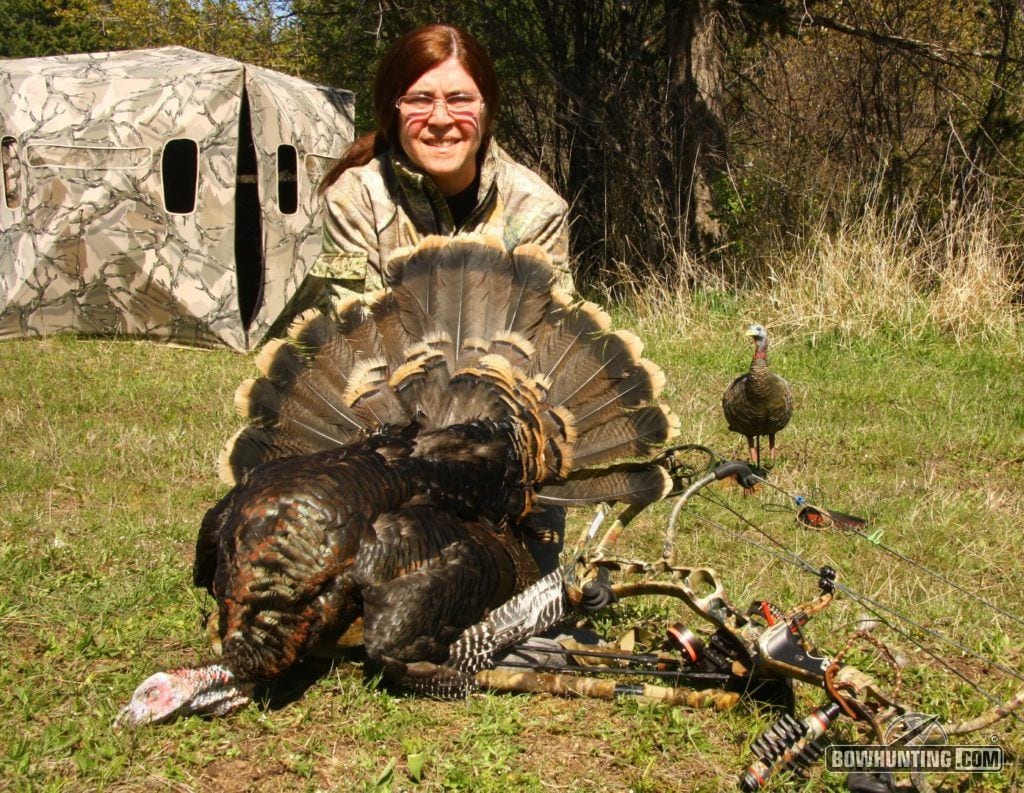
The turkey exception. The only exception to smaller heads remaining just as lethal as wide-cutting heads is on turkeys. Small vitals and a shifty nature almost demand a wide-cutting broadhead for regular success on spring gobblers.
But another factor many bowhunters fail to acknowledge is how an animal reacts immediately after being hit with an arrow. This is generally a matter of how wound up an animal is immediately before the shot, but maybe more importantly how much shock is imparted by your broadhead. That “watermelon thump” or “thwack” heard after a successful hit is an indication of how much shock an arrow/broadhead is delivering. The less efficient the broadhead design, the louder the sound of the hit will prove. It’s the difference between being poked with a sharp stick or punched with a closed fist. Big game animals become understandably alarmed when something slams into their side with a dramatic punching-bag thump. Sure, these animals are dead on their feet, but natural fight-or-flight responses kick in, adrenaline flows and they automatically begin gobbling ground in an attempt to distance themselves from eminent danger. An Olympic-caliber sprinter can cover 100 meters in 10 seconds, and I’d never bet on a man in a race against a white-tailed deer at the same distance, especially one on a panicked death run.
I could describe several instances where a 12-ringed animal hit with an aggressive, wide-cutting head traveled a remarkable distance, but a beautiful Oklahoma buck is the experience freshest in my mind. Shot on the level from a pop-up blind at only 18 yards, through both lungs with a nasty 2.3-inch two-blade mechanical, that buck traveled 200 yards. I was forced to track him following little scars in the dirt, as he also left little blood behind.
A 5×6 big-woods whitetail shot in Idaho last November makes an ideal contrast. This was a 6 ½-year-old buck who’d survived mountain lions, wolves and heavy rifle-hunting pressure. North Idaho white-tailed deer are as jumpy as they come. Simply hitting anchor is normally the biggest challenge to any encounter. This buck inched his way out of tight brush for a full 10 minutes, surveying the situation for danger before approaching a scrape and turning broadside at only 18 yards. As I tugged the bowstring to anchor the buck tensed. So I waited. But when he twitched his tail, indicating he would step forward, I released. The sleek G5 Outdoors Striker blasted through both lungs so fast, I initially believed I’d missed. But after running only 5 yards, ambling another 15 or 18, that buck paused and simply tipped over. He never knew what hit him. Even if he hadn’t settled within sight, the blood trail was impressive.
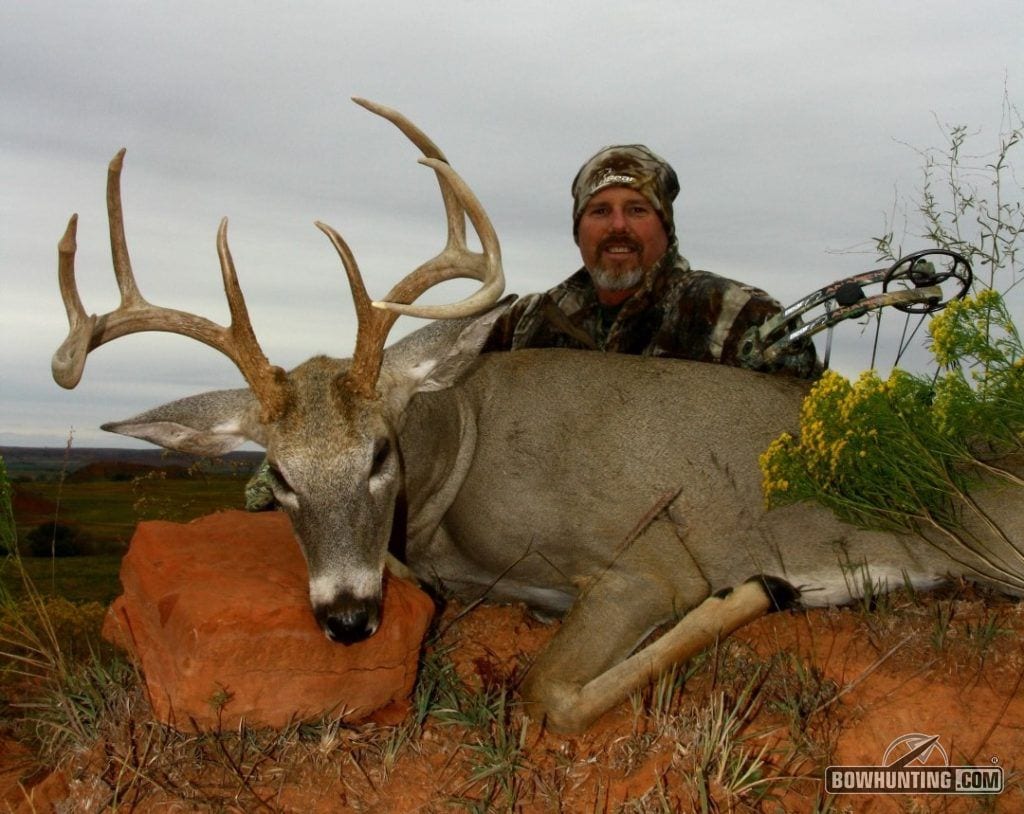
The author shot this ancient Idaho mountain buck with a 1 1/8-inch-wide mini fixed-blade head. The buck dropped in sight and left generous blood behind.
More dramatically, I well remember a B&C-quality black bear I killed off of bait nearly two decades ago. I was shooting a longbow, cedar arrow and two-blade, shaving-sharp Zwickey Black Diamond. The bear walked in, plopped before a barrel lying on its side and began raking pastries from the opening. Each time he did his armpit was exposed. I timed my draw to coincide with one of the big boar’s reaches, picking a spot tight in his armpit and releasing when it came into view. The arrow zipped through the bear and stuck into dirt on the opposite side. Blood began to pump from the wound. Yet the bear continued feasting. Finally, he seemed to hear his own blood spilling, rising to his feet and turning tight circles as if sniffing his own side. He promptly fell over without covering a single yard. It was one of the quickest kills I have ever witnessed with bow and arrow.
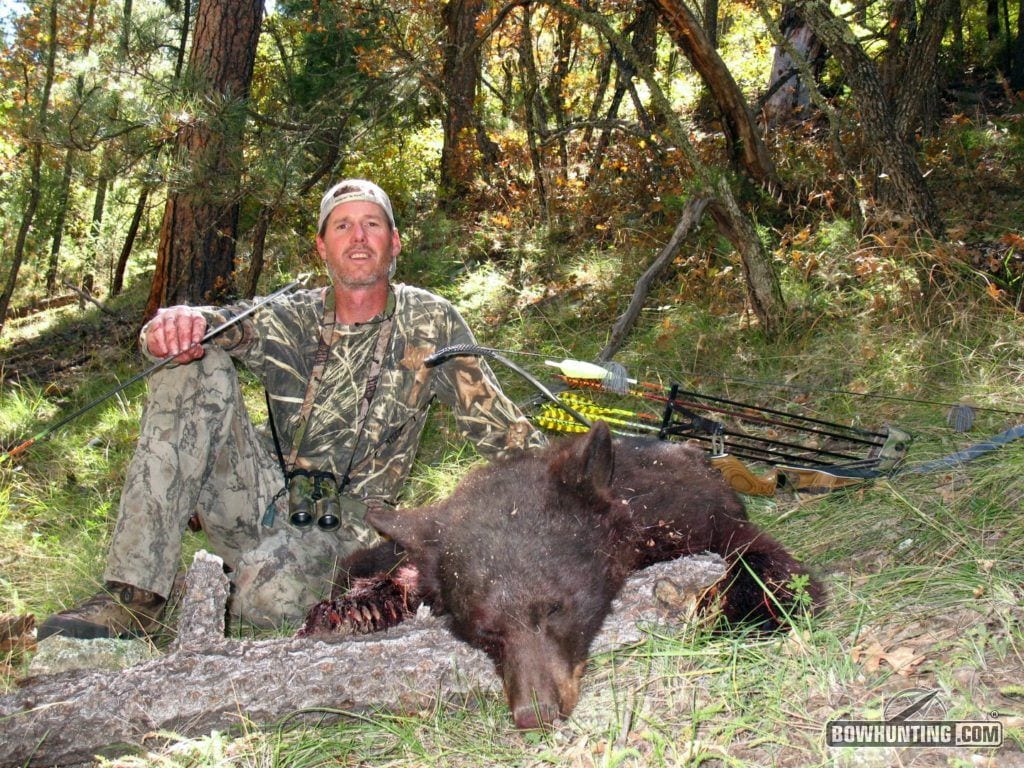
Author, Patrick Meitin, used a conservative-width cut-on-contact to cleanly take this P&Y-quality black bear with his recurve. The bear traveled only 70 yards and left a good blood trail behind.
A streamlined head, obviously, slips through animals so quickly and sleekly that animal often has no idea it has been hit at all. Try this: take a piece of rough carpet or leather and nail it between two heavy rail-road ties. Take two arrows; one tipped with wide-cutting mechanical and another with a sleek cutting-tip broadhead and attempt to push each through the stretched material. Most mechanicals require considerable effort to push through that material. A cut-on-contact head goes through effortlessly.
I don’t offer this information to encourage abandoning wide, aggressive mechanical designs (unless you’re not shooting enough energy to achieve complete penetration). I only offer this insight so those who must use a fixed-blade broadhead by law (like here in Idaho) or due to equipment limitations will understand forgoing the wider option does not necessarily mean tougher trailing after the hit–because wider heads don’t automatically lead to faster recovery.

 By
By 



